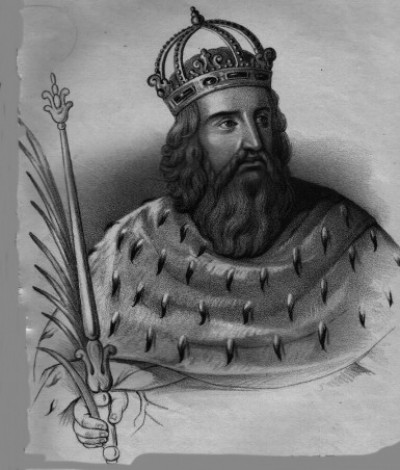The initial research results that corroborated the cause of Saint Erik’s death were saved as documents by the Church of Sweden.
There were no official documents at that time that mentioned the life and reign during his lifetime of Erik Jedvardsson, King Erik IX of Sweden who was later canonized as a Saint. The only information about this saint is the legend of the Swedish ruler, saved in written form in the 1290s, about 130 years after his death. Accordingly, King Erik ruled the country fairly, was a devout Catholic, led the holy war against Finland and fervently supported the church. He was killed in 1160 after 10 years in power and his remains were placed in the reliquary since 1257. Folk tales also record his tragic death in a battle outside his home. worship in Uppsala after just completing a mass.

Fresco depicting King Erik on the wall of Uppsala church – Photo: Uppsala church
Now, researchers have found factual details about the figure known as Eric the lawgiver, or Saint Erik, suggesting that his legend is true.
Life under the lens of science
The research project led by a team of Uppsala University experts was allowed to access Erik Jedvardsson’s relics to analyze the king’s remains. Previously, a comprehensive analysis was also carried out in 1946, but the results were still quite unclear. Many years later, having to wait until technology was more perfect, the Swedish Government decided to once again open the reliquary located at Uppsala church on April 23, 2014. Several groups of experts from various fields have embarked on the new project, and now the first results have been announced to the public.

The skull and crown are in the reliquary – photo: TT News Agency
Project team leader, professor of bone archeology Sabine Sten of Uppsala University, said that the research has provided unprecedented information about health status, genealogy based on genetics, and diet. and above all about the cause of death. The reliquary contained 23 bones from the same individual, alongside a shin bone from an unrelated person. Isotope analysis results confirmed the time of death was in 1160, while bone analysis showed that they belonged to a man, about 35-40 years old and 1m71 tall. X-ray examinations by Uppsala University Hospital did not detect any abnormalities in the person’s health.
Legend and mystery

King Erik IX reigned from 1155 until his death on May 18, 1160.
He was later canonized as a saint by Sweden. According to the Catholic Church, the feast day of Saint Erik is determined on May 18. Many rumors claim that King Erik died at the hands of Emund Ulvbane, an assassin hired by supporters of the Sverker dynasty to take control of the kingdom. Other sources accuse Magnus Henriksson, another claimant to the throne, of successfully replacing King Erik, albeit briefly.
A popular Swedish folk tale claims that a miracle occurred at the moment of the king’s death, in which a stream sprang up from the spot where his head fell. Also according to legend, King Erik was murdered after attending mass at the “Holy Trinity” church at Mons Domini in Uppsala. However, the current Trinity Church in Uppsala was built at the end of the 13th century, so it cannot be the church where the famous king’s death took place.
Meanwhile, DXA- and pQCT measurements showed that King Erik did not even have osteoporosis but had 25% more bone density than today’s adults. Overall, the king grew up in good nutritional conditions, with his bone structure suggesting he was extremely strong and physically active during his lifetime. Regarding diet, isotopic analysis allowed us to conclude that the Swedish king ate a lot of freshwater fish, which showed that he fully complied with the church’s regulations regarding Lent, a period of forced abstinence from food. meat dish. Stable isotope concentrations also revealed that King Erik did not spend his last 10 years in the Uppsala region but instead in the southern province of Vastergotland.
The last war
Based on the evidence obtained from the analysis process, experts can also know the cause of the king’s death in the prime of his life. Accordingly, the skull was dented due to one or two healed wounds, apparently from a weapon. The legend of Saint Erik records that he once led a holy war against Finland, and this may be the explanation for the head injuries. Also according to the only historical document about him, in the final battle, the enemy rushed in and surrounded the king, pushing him to the ground before using weapons to impale him until King Erik was half alive. half dead. Next, they insulted and finally beheaded the Swedish king.
The remains in the reliquary contained at least 9 cuts that could have killed the victim, with 7 of these located on the legs. There were no injuries to the ribs or upper arm bones, possibly because the king wore long armor that did not provide much protection to the lower body. Both shin bones had many wounds, indicating that the victim was lying on his stomach. A cervical vertebra was severed, and this could not have been done without stripping the victim of his armor. Based on that detail, experts confirm that there was a period of rest in the middle of the battle and was the time when they beheaded King Erik.
The new analysis provides initial information, and experts hope to collect more data in the coming year.





